University Report: Alternate Approaches to Strategic Management
VerifiedAdded on 2022/08/21
|15
|3464
|11
Report
AI Summary
This report provides an in-depth analysis of alternate approaches to strategic management, including the sustainable development approach, the stakeholder approach, and dynamic capabilities. It explores the history, benefits, and limitations of each approach, along with real-world examples of organizations that have successfully implemented them. The sustainable approach, exemplified by HSBC, focuses on environmentally conscious strategies. The stakeholder approach, as applied by Ford Motor Company, emphasizes creating value for all stakeholders, not just shareholders. Dynamic capabilities, illustrated by Apple, involve adapting internal and external advantages to changing market conditions. The report highlights the key capabilities required for each approach and concludes with a summary of the findings. This report is a valuable resource for students studying strategic management, and the full range of past papers and solved assignments are available on Desklib to aid in the learning process.
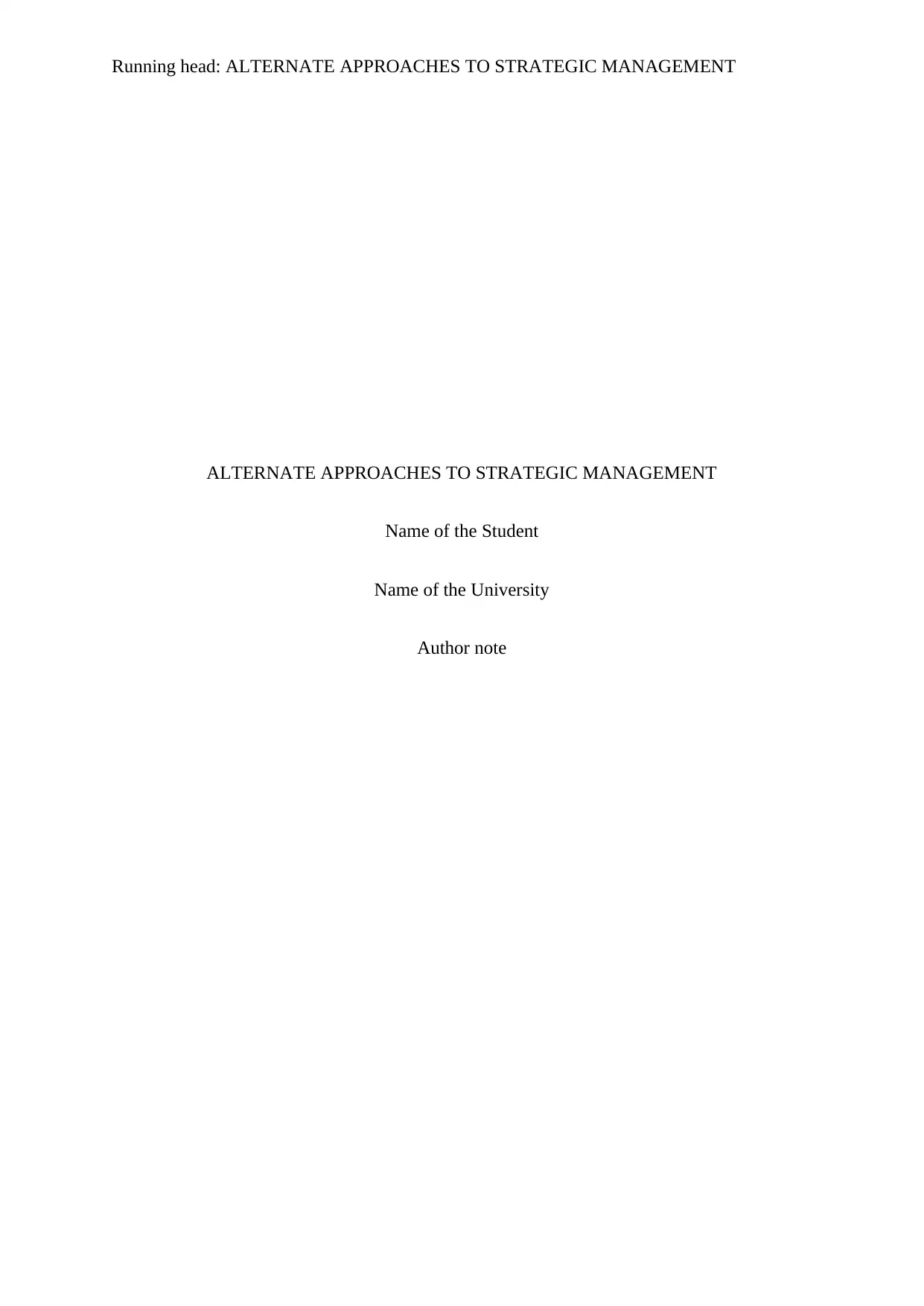
Running head: ALTERNATE APPROACHES TO STRATEGIC MANAGEMENT
ALTERNATE APPROACHES TO STRATEGIC MANAGEMENT
Name of the Student
Name of the University
Author note
ALTERNATE APPROACHES TO STRATEGIC MANAGEMENT
Name of the Student
Name of the University
Author note
Paraphrase This Document
Need a fresh take? Get an instant paraphrase of this document with our AI Paraphraser
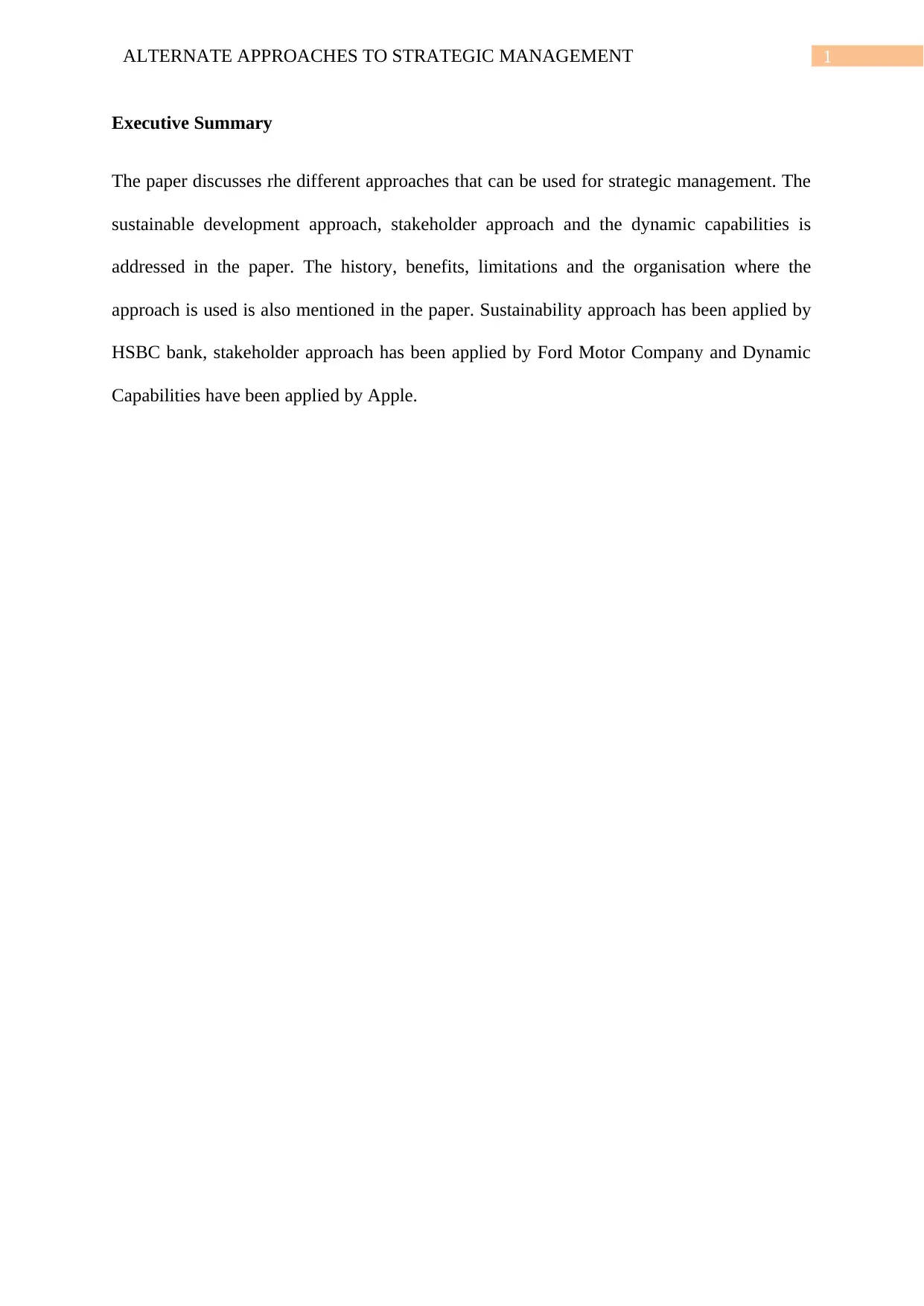
1ALTERNATE APPROACHES TO STRATEGIC MANAGEMENT
Executive Summary
The paper discusses rhe different approaches that can be used for strategic management. The
sustainable development approach, stakeholder approach and the dynamic capabilities is
addressed in the paper. The history, benefits, limitations and the organisation where the
approach is used is also mentioned in the paper. Sustainability approach has been applied by
HSBC bank, stakeholder approach has been applied by Ford Motor Company and Dynamic
Capabilities have been applied by Apple.
Executive Summary
The paper discusses rhe different approaches that can be used for strategic management. The
sustainable development approach, stakeholder approach and the dynamic capabilities is
addressed in the paper. The history, benefits, limitations and the organisation where the
approach is used is also mentioned in the paper. Sustainability approach has been applied by
HSBC bank, stakeholder approach has been applied by Ford Motor Company and Dynamic
Capabilities have been applied by Apple.
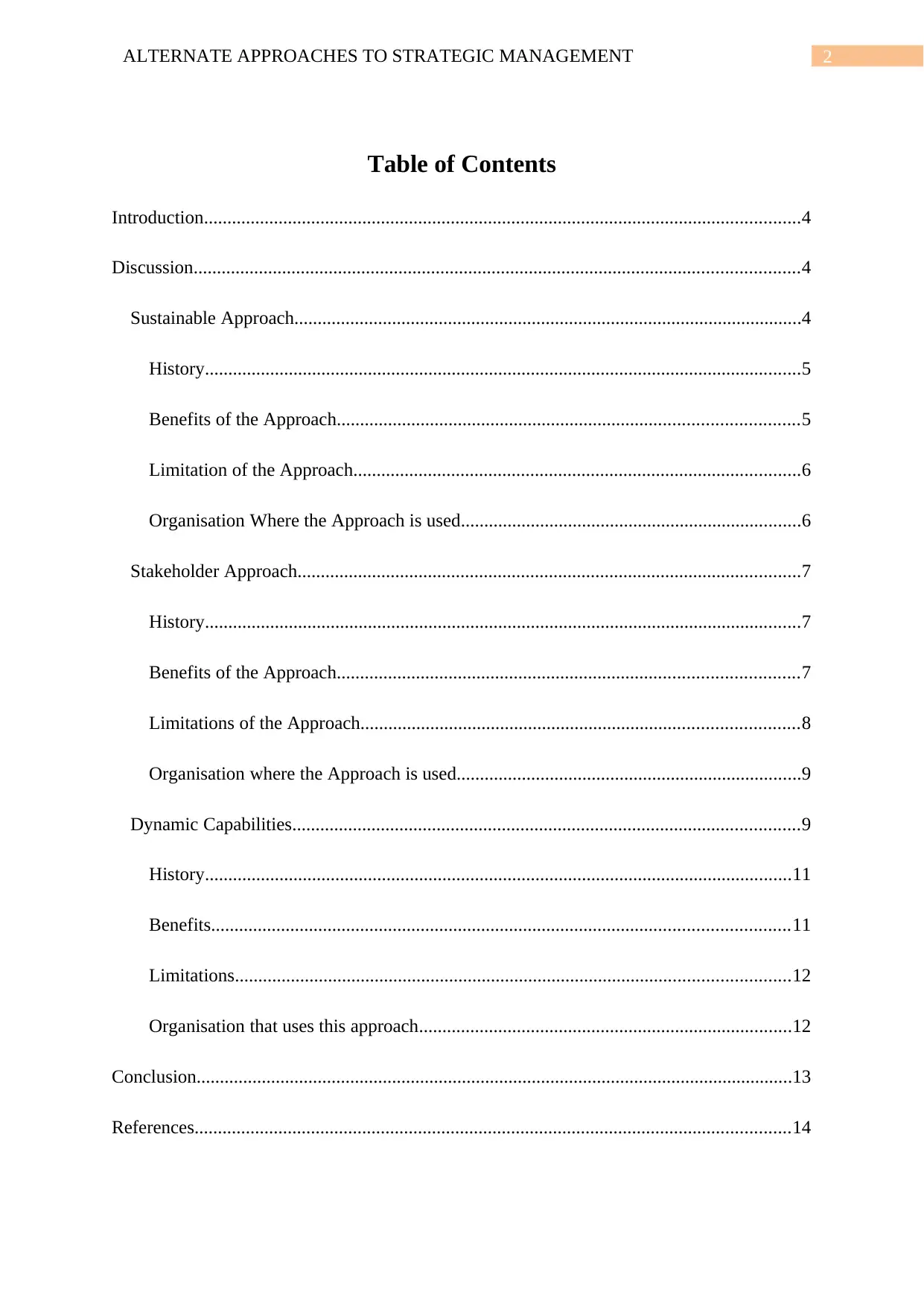
2ALTERNATE APPROACHES TO STRATEGIC MANAGEMENT
Table of Contents
Introduction................................................................................................................................4
Discussion..................................................................................................................................4
Sustainable Approach.............................................................................................................4
History................................................................................................................................5
Benefits of the Approach...................................................................................................5
Limitation of the Approach................................................................................................6
Organisation Where the Approach is used.........................................................................6
Stakeholder Approach............................................................................................................7
History................................................................................................................................7
Benefits of the Approach...................................................................................................7
Limitations of the Approach..............................................................................................8
Organisation where the Approach is used..........................................................................9
Dynamic Capabilities.............................................................................................................9
History..............................................................................................................................11
Benefits............................................................................................................................11
Limitations.......................................................................................................................12
Organisation that uses this approach................................................................................12
Conclusion................................................................................................................................13
References................................................................................................................................14
Table of Contents
Introduction................................................................................................................................4
Discussion..................................................................................................................................4
Sustainable Approach.............................................................................................................4
History................................................................................................................................5
Benefits of the Approach...................................................................................................5
Limitation of the Approach................................................................................................6
Organisation Where the Approach is used.........................................................................6
Stakeholder Approach............................................................................................................7
History................................................................................................................................7
Benefits of the Approach...................................................................................................7
Limitations of the Approach..............................................................................................8
Organisation where the Approach is used..........................................................................9
Dynamic Capabilities.............................................................................................................9
History..............................................................................................................................11
Benefits............................................................................................................................11
Limitations.......................................................................................................................12
Organisation that uses this approach................................................................................12
Conclusion................................................................................................................................13
References................................................................................................................................14
⊘ This is a preview!⊘
Do you want full access?
Subscribe today to unlock all pages.

Trusted by 1+ million students worldwide
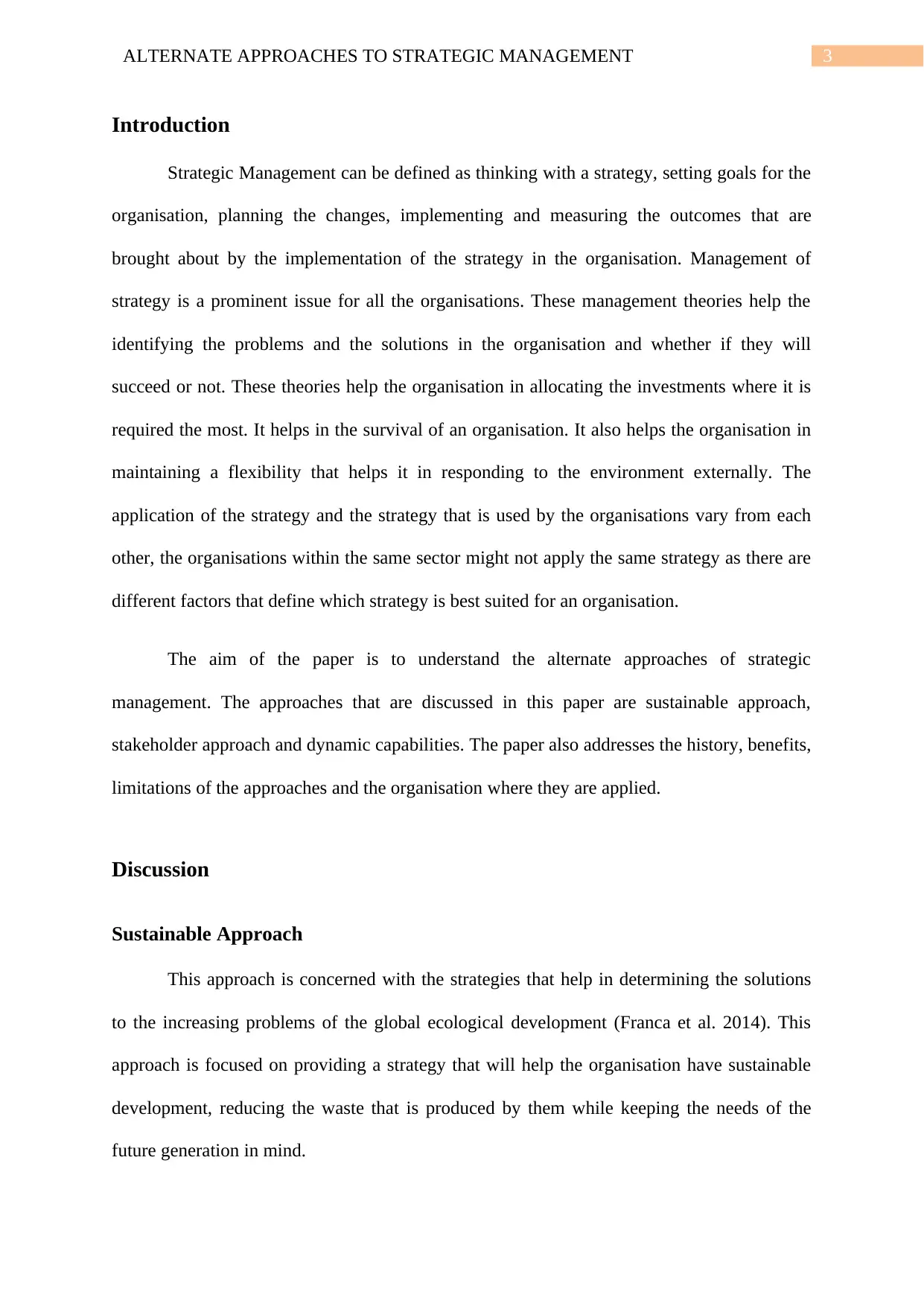
3ALTERNATE APPROACHES TO STRATEGIC MANAGEMENT
Introduction
Strategic Management can be defined as thinking with a strategy, setting goals for the
organisation, planning the changes, implementing and measuring the outcomes that are
brought about by the implementation of the strategy in the organisation. Management of
strategy is a prominent issue for all the organisations. These management theories help the
identifying the problems and the solutions in the organisation and whether if they will
succeed or not. These theories help the organisation in allocating the investments where it is
required the most. It helps in the survival of an organisation. It also helps the organisation in
maintaining a flexibility that helps it in responding to the environment externally. The
application of the strategy and the strategy that is used by the organisations vary from each
other, the organisations within the same sector might not apply the same strategy as there are
different factors that define which strategy is best suited for an organisation.
The aim of the paper is to understand the alternate approaches of strategic
management. The approaches that are discussed in this paper are sustainable approach,
stakeholder approach and dynamic capabilities. The paper also addresses the history, benefits,
limitations of the approaches and the organisation where they are applied.
Discussion
Sustainable Approach
This approach is concerned with the strategies that help in determining the solutions
to the increasing problems of the global ecological development (Franca et al. 2014). This
approach is focused on providing a strategy that will help the organisation have sustainable
development, reducing the waste that is produced by them while keeping the needs of the
future generation in mind.
Introduction
Strategic Management can be defined as thinking with a strategy, setting goals for the
organisation, planning the changes, implementing and measuring the outcomes that are
brought about by the implementation of the strategy in the organisation. Management of
strategy is a prominent issue for all the organisations. These management theories help the
identifying the problems and the solutions in the organisation and whether if they will
succeed or not. These theories help the organisation in allocating the investments where it is
required the most. It helps in the survival of an organisation. It also helps the organisation in
maintaining a flexibility that helps it in responding to the environment externally. The
application of the strategy and the strategy that is used by the organisations vary from each
other, the organisations within the same sector might not apply the same strategy as there are
different factors that define which strategy is best suited for an organisation.
The aim of the paper is to understand the alternate approaches of strategic
management. The approaches that are discussed in this paper are sustainable approach,
stakeholder approach and dynamic capabilities. The paper also addresses the history, benefits,
limitations of the approaches and the organisation where they are applied.
Discussion
Sustainable Approach
This approach is concerned with the strategies that help in determining the solutions
to the increasing problems of the global ecological development (Franca et al. 2014). This
approach is focused on providing a strategy that will help the organisation have sustainable
development, reducing the waste that is produced by them while keeping the needs of the
future generation in mind.
Paraphrase This Document
Need a fresh take? Get an instant paraphrase of this document with our AI Paraphraser
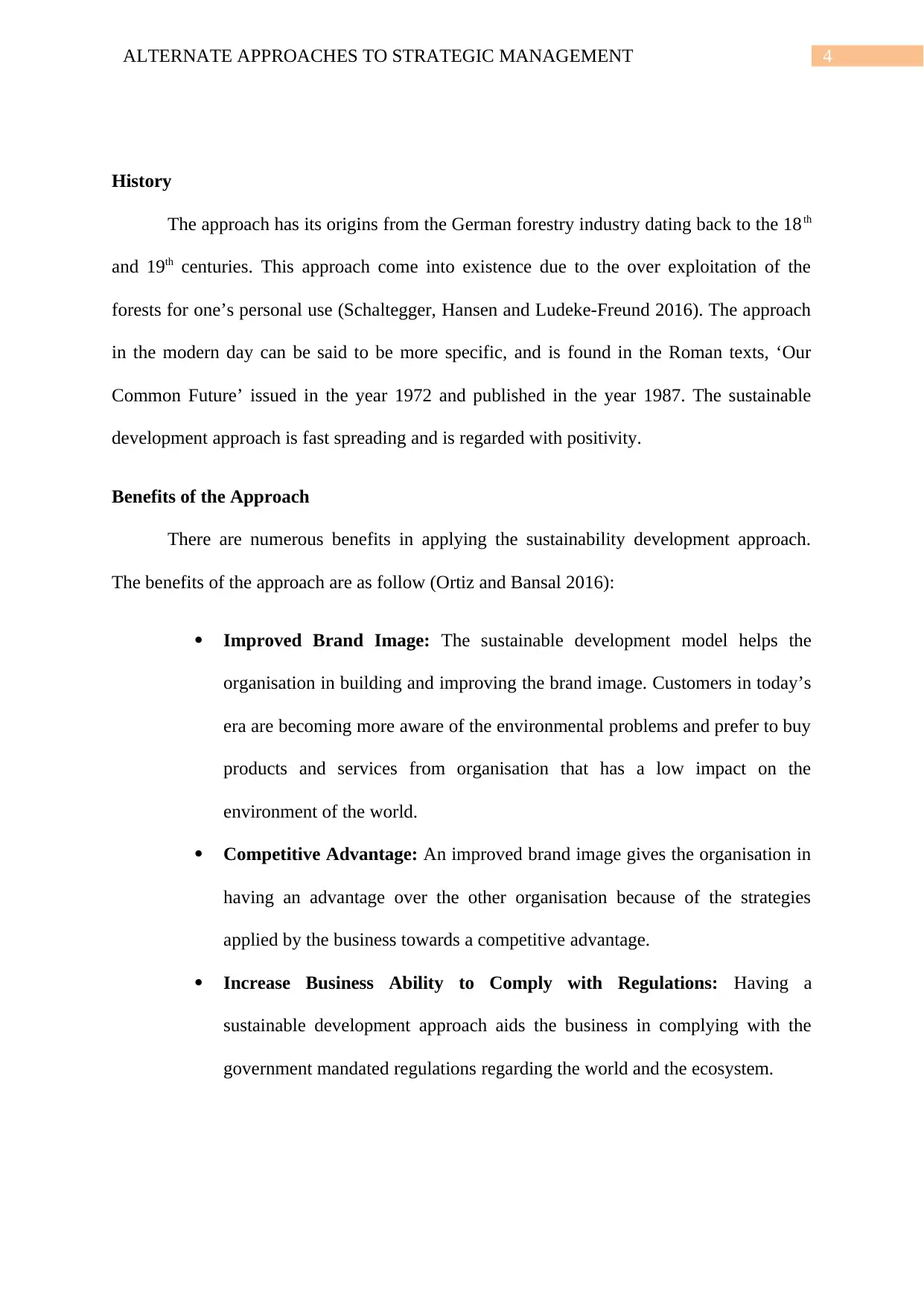
4ALTERNATE APPROACHES TO STRATEGIC MANAGEMENT
History
The approach has its origins from the German forestry industry dating back to the 18th
and 19th centuries. This approach come into existence due to the over exploitation of the
forests for one’s personal use (Schaltegger, Hansen and Ludeke-Freund 2016). The approach
in the modern day can be said to be more specific, and is found in the Roman texts, ‘Our
Common Future’ issued in the year 1972 and published in the year 1987. The sustainable
development approach is fast spreading and is regarded with positivity.
Benefits of the Approach
There are numerous benefits in applying the sustainability development approach.
The benefits of the approach are as follow (Ortiz and Bansal 2016):
Improved Brand Image: The sustainable development model helps the
organisation in building and improving the brand image. Customers in today’s
era are becoming more aware of the environmental problems and prefer to buy
products and services from organisation that has a low impact on the
environment of the world.
Competitive Advantage: An improved brand image gives the organisation in
having an advantage over the other organisation because of the strategies
applied by the business towards a competitive advantage.
Increase Business Ability to Comply with Regulations: Having a
sustainable development approach aids the business in complying with the
government mandated regulations regarding the world and the ecosystem.
History
The approach has its origins from the German forestry industry dating back to the 18th
and 19th centuries. This approach come into existence due to the over exploitation of the
forests for one’s personal use (Schaltegger, Hansen and Ludeke-Freund 2016). The approach
in the modern day can be said to be more specific, and is found in the Roman texts, ‘Our
Common Future’ issued in the year 1972 and published in the year 1987. The sustainable
development approach is fast spreading and is regarded with positivity.
Benefits of the Approach
There are numerous benefits in applying the sustainability development approach.
The benefits of the approach are as follow (Ortiz and Bansal 2016):
Improved Brand Image: The sustainable development model helps the
organisation in building and improving the brand image. Customers in today’s
era are becoming more aware of the environmental problems and prefer to buy
products and services from organisation that has a low impact on the
environment of the world.
Competitive Advantage: An improved brand image gives the organisation in
having an advantage over the other organisation because of the strategies
applied by the business towards a competitive advantage.
Increase Business Ability to Comply with Regulations: Having a
sustainable development approach aids the business in complying with the
government mandated regulations regarding the world and the ecosystem.
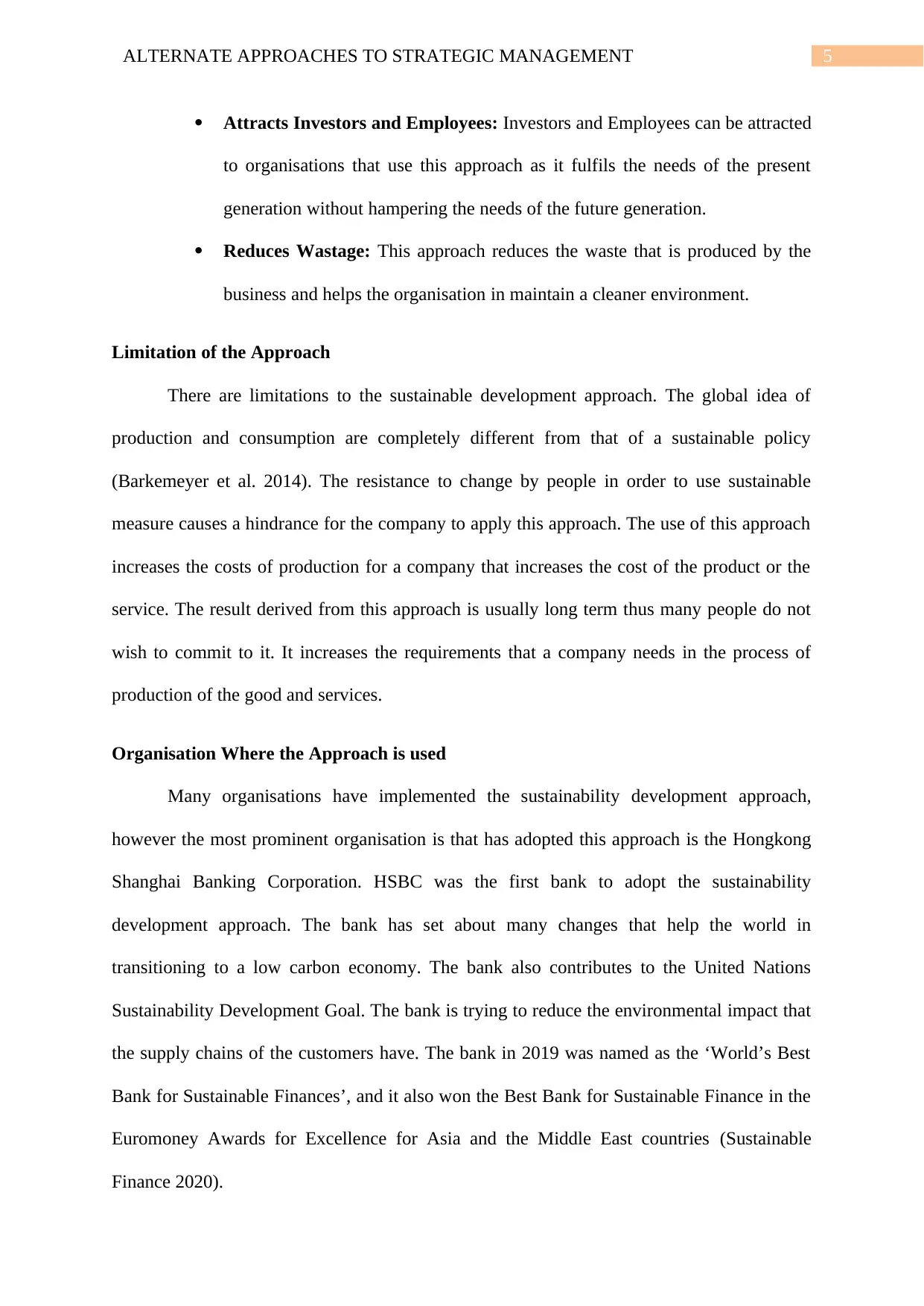
5ALTERNATE APPROACHES TO STRATEGIC MANAGEMENT
Attracts Investors and Employees: Investors and Employees can be attracted
to organisations that use this approach as it fulfils the needs of the present
generation without hampering the needs of the future generation.
Reduces Wastage: This approach reduces the waste that is produced by the
business and helps the organisation in maintain a cleaner environment.
Limitation of the Approach
There are limitations to the sustainable development approach. The global idea of
production and consumption are completely different from that of a sustainable policy
(Barkemeyer et al. 2014). The resistance to change by people in order to use sustainable
measure causes a hindrance for the company to apply this approach. The use of this approach
increases the costs of production for a company that increases the cost of the product or the
service. The result derived from this approach is usually long term thus many people do not
wish to commit to it. It increases the requirements that a company needs in the process of
production of the good and services.
Organisation Where the Approach is used
Many organisations have implemented the sustainability development approach,
however the most prominent organisation is that has adopted this approach is the Hongkong
Shanghai Banking Corporation. HSBC was the first bank to adopt the sustainability
development approach. The bank has set about many changes that help the world in
transitioning to a low carbon economy. The bank also contributes to the United Nations
Sustainability Development Goal. The bank is trying to reduce the environmental impact that
the supply chains of the customers have. The bank in 2019 was named as the ‘World’s Best
Bank for Sustainable Finances’, and it also won the Best Bank for Sustainable Finance in the
Euromoney Awards for Excellence for Asia and the Middle East countries (Sustainable
Finance 2020).
Attracts Investors and Employees: Investors and Employees can be attracted
to organisations that use this approach as it fulfils the needs of the present
generation without hampering the needs of the future generation.
Reduces Wastage: This approach reduces the waste that is produced by the
business and helps the organisation in maintain a cleaner environment.
Limitation of the Approach
There are limitations to the sustainable development approach. The global idea of
production and consumption are completely different from that of a sustainable policy
(Barkemeyer et al. 2014). The resistance to change by people in order to use sustainable
measure causes a hindrance for the company to apply this approach. The use of this approach
increases the costs of production for a company that increases the cost of the product or the
service. The result derived from this approach is usually long term thus many people do not
wish to commit to it. It increases the requirements that a company needs in the process of
production of the good and services.
Organisation Where the Approach is used
Many organisations have implemented the sustainability development approach,
however the most prominent organisation is that has adopted this approach is the Hongkong
Shanghai Banking Corporation. HSBC was the first bank to adopt the sustainability
development approach. The bank has set about many changes that help the world in
transitioning to a low carbon economy. The bank also contributes to the United Nations
Sustainability Development Goal. The bank is trying to reduce the environmental impact that
the supply chains of the customers have. The bank in 2019 was named as the ‘World’s Best
Bank for Sustainable Finances’, and it also won the Best Bank for Sustainable Finance in the
Euromoney Awards for Excellence for Asia and the Middle East countries (Sustainable
Finance 2020).
⊘ This is a preview!⊘
Do you want full access?
Subscribe today to unlock all pages.

Trusted by 1+ million students worldwide
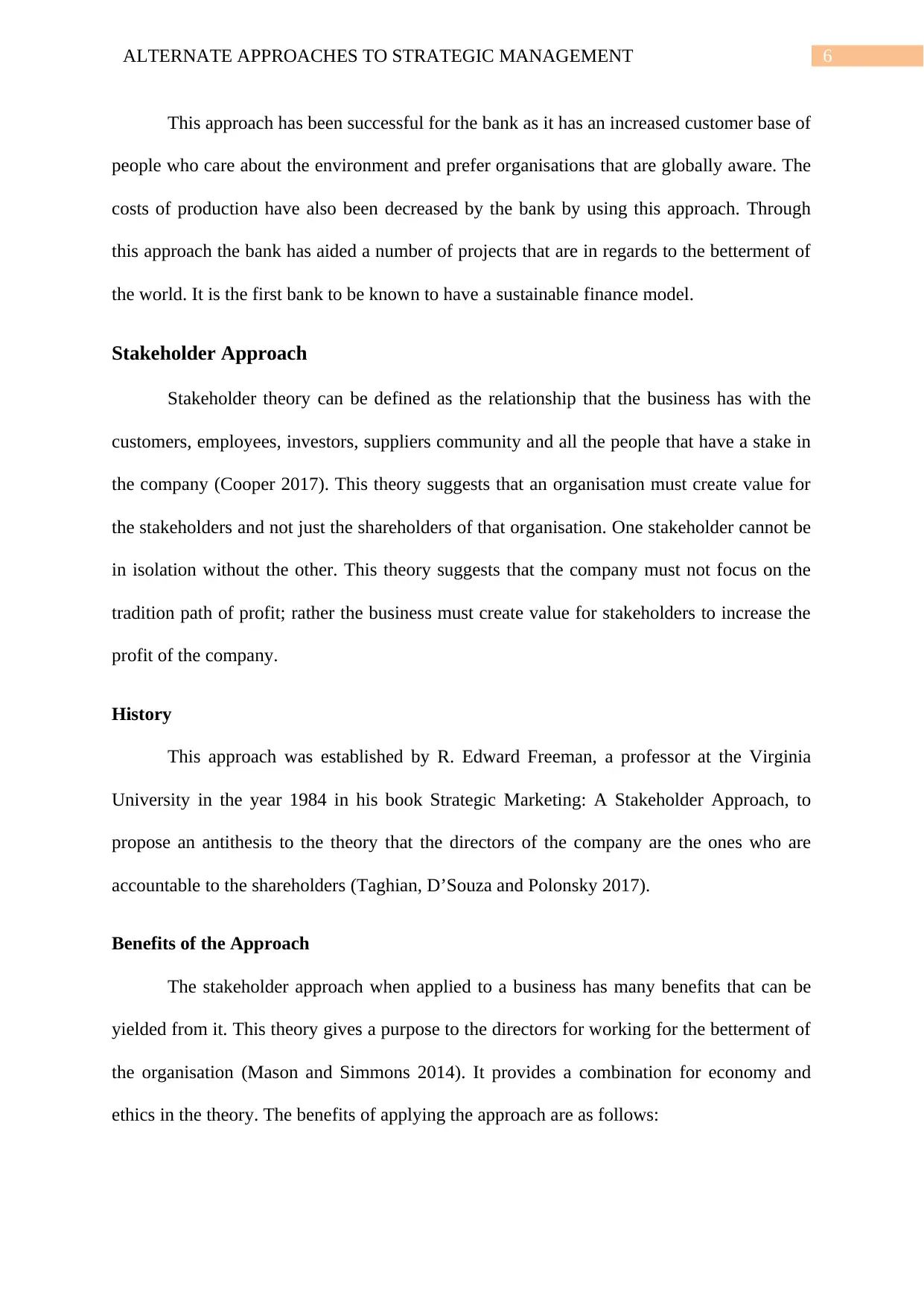
6ALTERNATE APPROACHES TO STRATEGIC MANAGEMENT
This approach has been successful for the bank as it has an increased customer base of
people who care about the environment and prefer organisations that are globally aware. The
costs of production have also been decreased by the bank by using this approach. Through
this approach the bank has aided a number of projects that are in regards to the betterment of
the world. It is the first bank to be known to have a sustainable finance model.
Stakeholder Approach
Stakeholder theory can be defined as the relationship that the business has with the
customers, employees, investors, suppliers community and all the people that have a stake in
the company (Cooper 2017). This theory suggests that an organisation must create value for
the stakeholders and not just the shareholders of that organisation. One stakeholder cannot be
in isolation without the other. This theory suggests that the company must not focus on the
tradition path of profit; rather the business must create value for stakeholders to increase the
profit of the company.
History
This approach was established by R. Edward Freeman, a professor at the Virginia
University in the year 1984 in his book Strategic Marketing: A Stakeholder Approach, to
propose an antithesis to the theory that the directors of the company are the ones who are
accountable to the shareholders (Taghian, D’Souza and Polonsky 2017).
Benefits of the Approach
The stakeholder approach when applied to a business has many benefits that can be
yielded from it. This theory gives a purpose to the directors for working for the betterment of
the organisation (Mason and Simmons 2014). It provides a combination for economy and
ethics in the theory. The benefits of applying the approach are as follows:
This approach has been successful for the bank as it has an increased customer base of
people who care about the environment and prefer organisations that are globally aware. The
costs of production have also been decreased by the bank by using this approach. Through
this approach the bank has aided a number of projects that are in regards to the betterment of
the world. It is the first bank to be known to have a sustainable finance model.
Stakeholder Approach
Stakeholder theory can be defined as the relationship that the business has with the
customers, employees, investors, suppliers community and all the people that have a stake in
the company (Cooper 2017). This theory suggests that an organisation must create value for
the stakeholders and not just the shareholders of that organisation. One stakeholder cannot be
in isolation without the other. This theory suggests that the company must not focus on the
tradition path of profit; rather the business must create value for stakeholders to increase the
profit of the company.
History
This approach was established by R. Edward Freeman, a professor at the Virginia
University in the year 1984 in his book Strategic Marketing: A Stakeholder Approach, to
propose an antithesis to the theory that the directors of the company are the ones who are
accountable to the shareholders (Taghian, D’Souza and Polonsky 2017).
Benefits of the Approach
The stakeholder approach when applied to a business has many benefits that can be
yielded from it. This theory gives a purpose to the directors for working for the betterment of
the organisation (Mason and Simmons 2014). It provides a combination for economy and
ethics in the theory. The benefits of applying the approach are as follows:
Paraphrase This Document
Need a fresh take? Get an instant paraphrase of this document with our AI Paraphraser
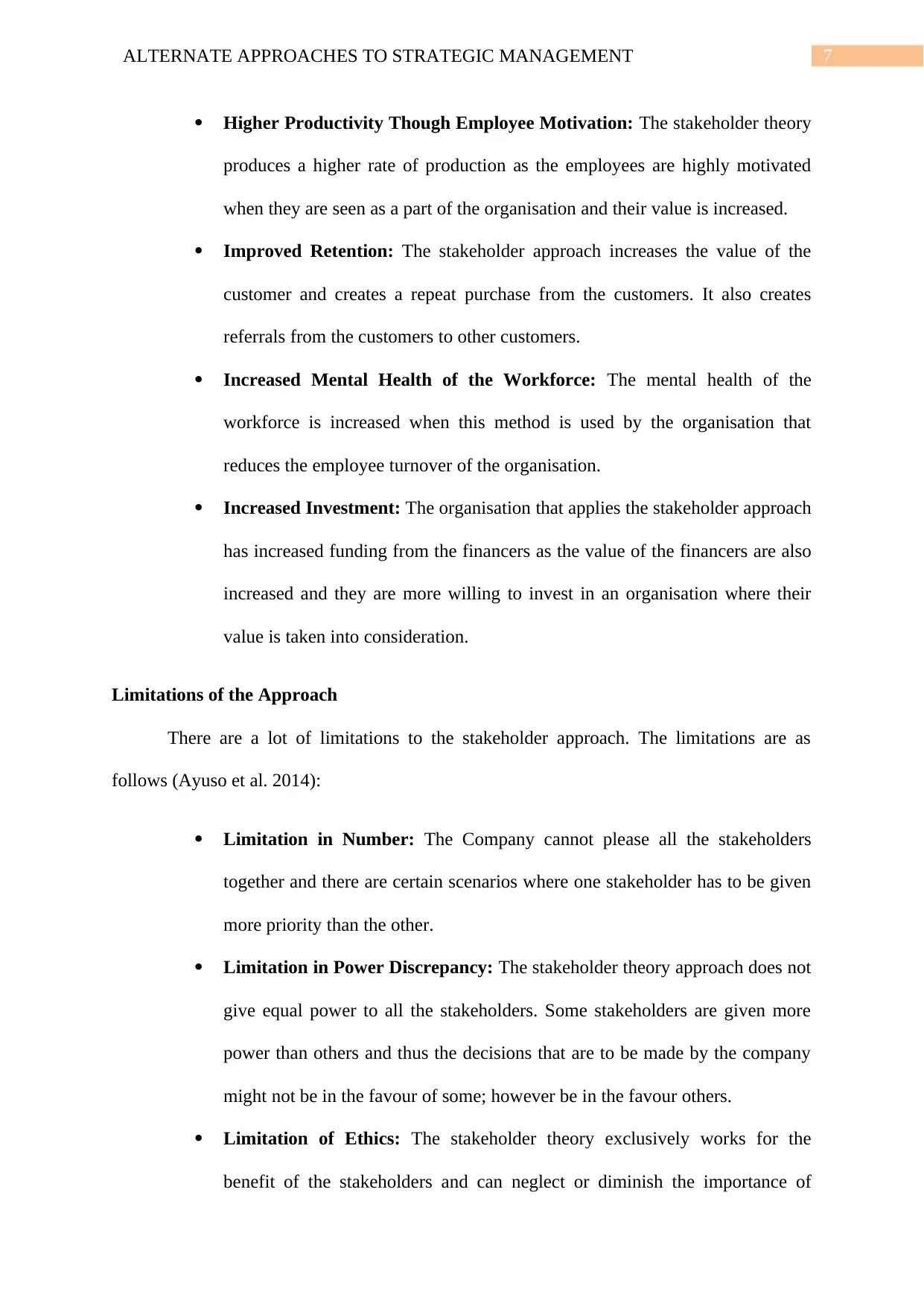
7ALTERNATE APPROACHES TO STRATEGIC MANAGEMENT
Higher Productivity Though Employee Motivation: The stakeholder theory
produces a higher rate of production as the employees are highly motivated
when they are seen as a part of the organisation and their value is increased.
Improved Retention: The stakeholder approach increases the value of the
customer and creates a repeat purchase from the customers. It also creates
referrals from the customers to other customers.
Increased Mental Health of the Workforce: The mental health of the
workforce is increased when this method is used by the organisation that
reduces the employee turnover of the organisation.
Increased Investment: The organisation that applies the stakeholder approach
has increased funding from the financers as the value of the financers are also
increased and they are more willing to invest in an organisation where their
value is taken into consideration.
Limitations of the Approach
There are a lot of limitations to the stakeholder approach. The limitations are as
follows (Ayuso et al. 2014):
Limitation in Number: The Company cannot please all the stakeholders
together and there are certain scenarios where one stakeholder has to be given
more priority than the other.
Limitation in Power Discrepancy: The stakeholder theory approach does not
give equal power to all the stakeholders. Some stakeholders are given more
power than others and thus the decisions that are to be made by the company
might not be in the favour of some; however be in the favour others.
Limitation of Ethics: The stakeholder theory exclusively works for the
benefit of the stakeholders and can neglect or diminish the importance of
Higher Productivity Though Employee Motivation: The stakeholder theory
produces a higher rate of production as the employees are highly motivated
when they are seen as a part of the organisation and their value is increased.
Improved Retention: The stakeholder approach increases the value of the
customer and creates a repeat purchase from the customers. It also creates
referrals from the customers to other customers.
Increased Mental Health of the Workforce: The mental health of the
workforce is increased when this method is used by the organisation that
reduces the employee turnover of the organisation.
Increased Investment: The organisation that applies the stakeholder approach
has increased funding from the financers as the value of the financers are also
increased and they are more willing to invest in an organisation where their
value is taken into consideration.
Limitations of the Approach
There are a lot of limitations to the stakeholder approach. The limitations are as
follows (Ayuso et al. 2014):
Limitation in Number: The Company cannot please all the stakeholders
together and there are certain scenarios where one stakeholder has to be given
more priority than the other.
Limitation in Power Discrepancy: The stakeholder theory approach does not
give equal power to all the stakeholders. Some stakeholders are given more
power than others and thus the decisions that are to be made by the company
might not be in the favour of some; however be in the favour others.
Limitation of Ethics: The stakeholder theory exclusively works for the
benefit of the stakeholders and can neglect or diminish the importance of
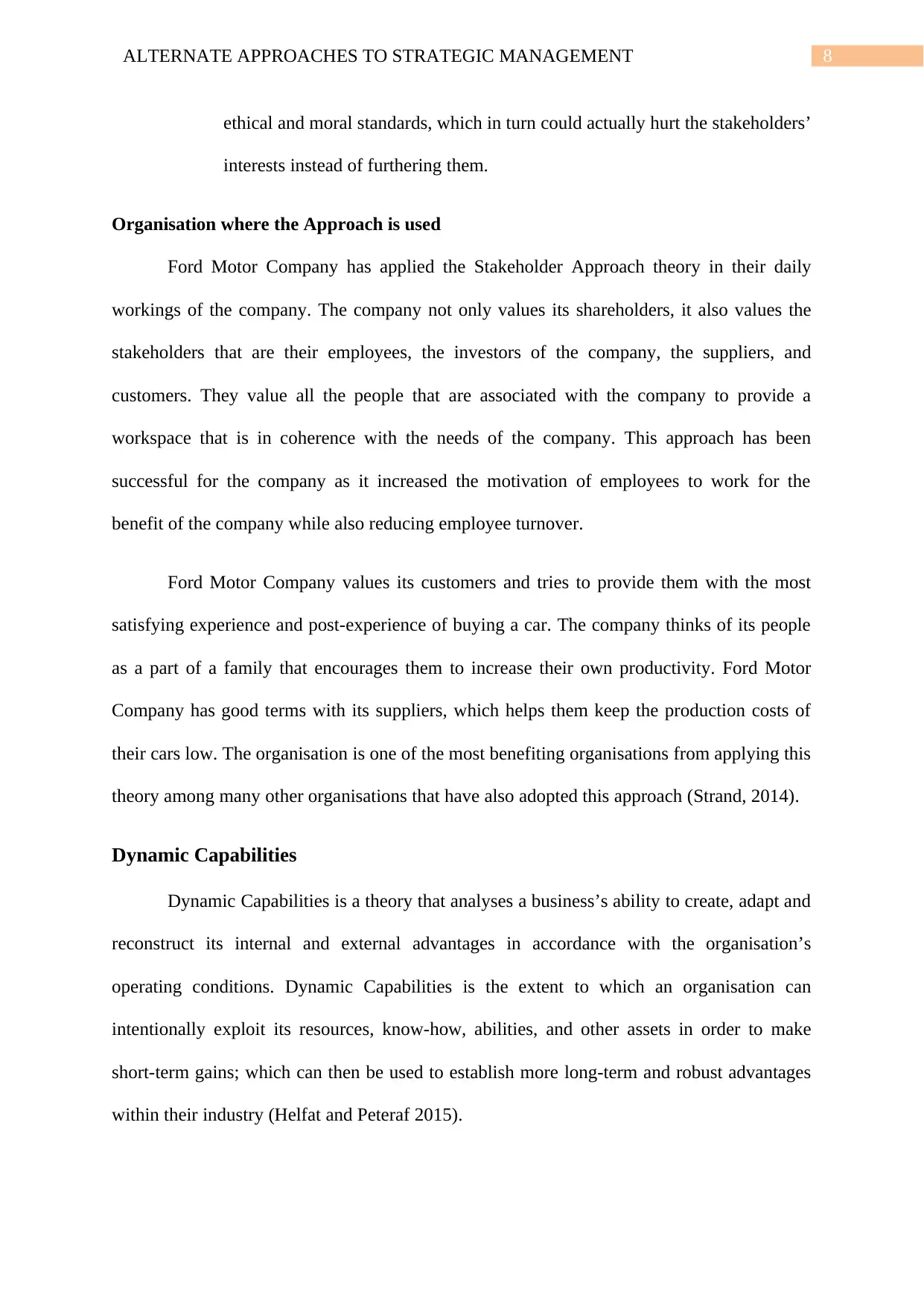
8ALTERNATE APPROACHES TO STRATEGIC MANAGEMENT
ethical and moral standards, which in turn could actually hurt the stakeholders’
interests instead of furthering them.
Organisation where the Approach is used
Ford Motor Company has applied the Stakeholder Approach theory in their daily
workings of the company. The company not only values its shareholders, it also values the
stakeholders that are their employees, the investors of the company, the suppliers, and
customers. They value all the people that are associated with the company to provide a
workspace that is in coherence with the needs of the company. This approach has been
successful for the company as it increased the motivation of employees to work for the
benefit of the company while also reducing employee turnover.
Ford Motor Company values its customers and tries to provide them with the most
satisfying experience and post-experience of buying a car. The company thinks of its people
as a part of a family that encourages them to increase their own productivity. Ford Motor
Company has good terms with its suppliers, which helps them keep the production costs of
their cars low. The organisation is one of the most benefiting organisations from applying this
theory among many other organisations that have also adopted this approach (Strand, 2014).
Dynamic Capabilities
Dynamic Capabilities is a theory that analyses a business’s ability to create, adapt and
reconstruct its internal and external advantages in accordance with the organisation’s
operating conditions. Dynamic Capabilities is the extent to which an organisation can
intentionally exploit its resources, know-how, abilities, and other assets in order to make
short-term gains; which can then be used to establish more long-term and robust advantages
within their industry (Helfat and Peteraf 2015).
ethical and moral standards, which in turn could actually hurt the stakeholders’
interests instead of furthering them.
Organisation where the Approach is used
Ford Motor Company has applied the Stakeholder Approach theory in their daily
workings of the company. The company not only values its shareholders, it also values the
stakeholders that are their employees, the investors of the company, the suppliers, and
customers. They value all the people that are associated with the company to provide a
workspace that is in coherence with the needs of the company. This approach has been
successful for the company as it increased the motivation of employees to work for the
benefit of the company while also reducing employee turnover.
Ford Motor Company values its customers and tries to provide them with the most
satisfying experience and post-experience of buying a car. The company thinks of its people
as a part of a family that encourages them to increase their own productivity. Ford Motor
Company has good terms with its suppliers, which helps them keep the production costs of
their cars low. The organisation is one of the most benefiting organisations from applying this
theory among many other organisations that have also adopted this approach (Strand, 2014).
Dynamic Capabilities
Dynamic Capabilities is a theory that analyses a business’s ability to create, adapt and
reconstruct its internal and external advantages in accordance with the organisation’s
operating conditions. Dynamic Capabilities is the extent to which an organisation can
intentionally exploit its resources, know-how, abilities, and other assets in order to make
short-term gains; which can then be used to establish more long-term and robust advantages
within their industry (Helfat and Peteraf 2015).
⊘ This is a preview!⊘
Do you want full access?
Subscribe today to unlock all pages.

Trusted by 1+ million students worldwide
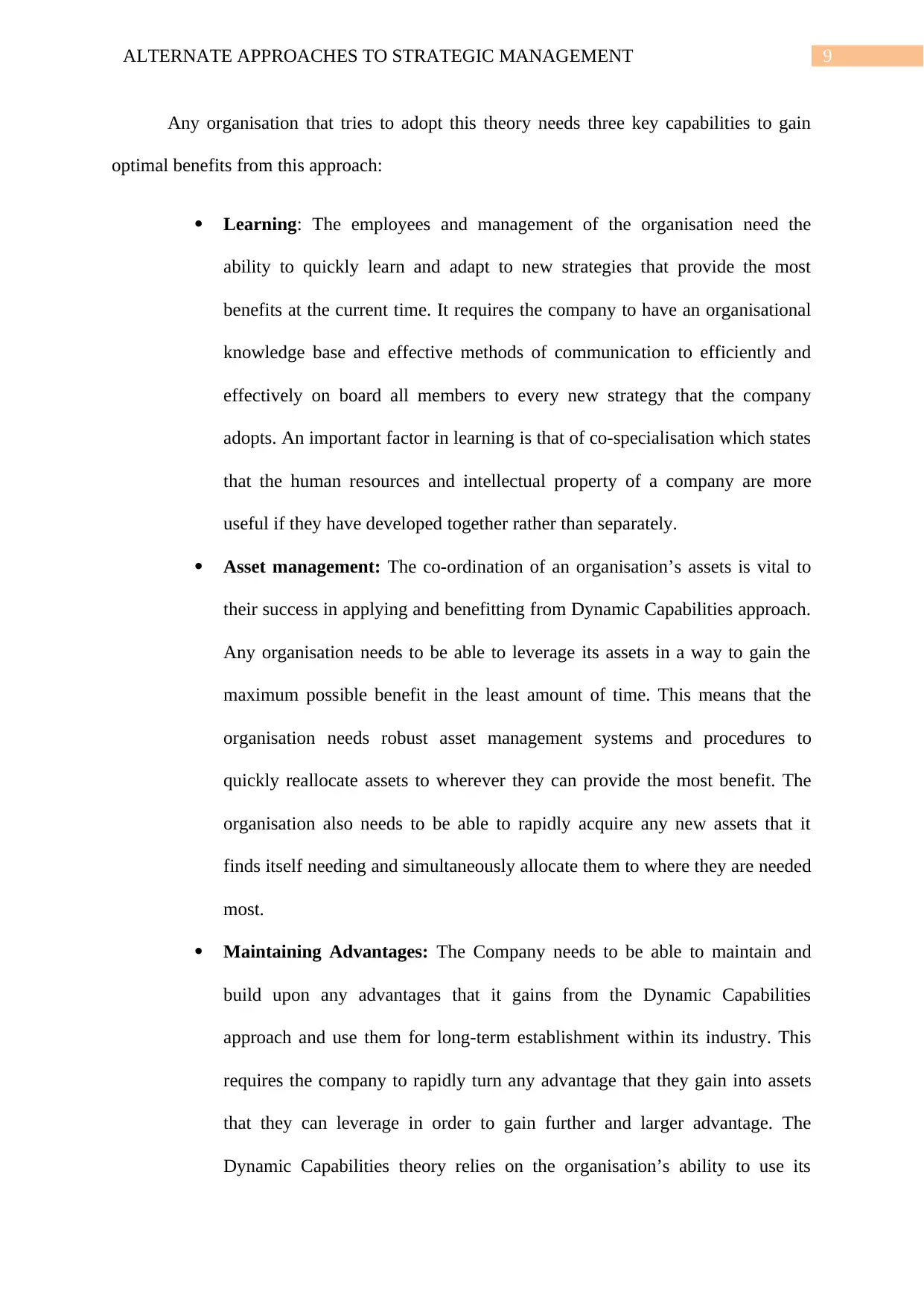
9ALTERNATE APPROACHES TO STRATEGIC MANAGEMENT
Any organisation that tries to adopt this theory needs three key capabilities to gain
optimal benefits from this approach:
Learning: The employees and management of the organisation need the
ability to quickly learn and adapt to new strategies that provide the most
benefits at the current time. It requires the company to have an organisational
knowledge base and effective methods of communication to efficiently and
effectively on board all members to every new strategy that the company
adopts. An important factor in learning is that of co-specialisation which states
that the human resources and intellectual property of a company are more
useful if they have developed together rather than separately.
Asset management: The co-ordination of an organisation’s assets is vital to
their success in applying and benefitting from Dynamic Capabilities approach.
Any organisation needs to be able to leverage its assets in a way to gain the
maximum possible benefit in the least amount of time. This means that the
organisation needs robust asset management systems and procedures to
quickly reallocate assets to wherever they can provide the most benefit. The
organisation also needs to be able to rapidly acquire any new assets that it
finds itself needing and simultaneously allocate them to where they are needed
most.
Maintaining Advantages: The Company needs to be able to maintain and
build upon any advantages that it gains from the Dynamic Capabilities
approach and use them for long-term establishment within its industry. This
requires the company to rapidly turn any advantage that they gain into assets
that they can leverage in order to gain further and larger advantage. The
Dynamic Capabilities theory relies on the organisation’s ability to use its
Any organisation that tries to adopt this theory needs three key capabilities to gain
optimal benefits from this approach:
Learning: The employees and management of the organisation need the
ability to quickly learn and adapt to new strategies that provide the most
benefits at the current time. It requires the company to have an organisational
knowledge base and effective methods of communication to efficiently and
effectively on board all members to every new strategy that the company
adopts. An important factor in learning is that of co-specialisation which states
that the human resources and intellectual property of a company are more
useful if they have developed together rather than separately.
Asset management: The co-ordination of an organisation’s assets is vital to
their success in applying and benefitting from Dynamic Capabilities approach.
Any organisation needs to be able to leverage its assets in a way to gain the
maximum possible benefit in the least amount of time. This means that the
organisation needs robust asset management systems and procedures to
quickly reallocate assets to wherever they can provide the most benefit. The
organisation also needs to be able to rapidly acquire any new assets that it
finds itself needing and simultaneously allocate them to where they are needed
most.
Maintaining Advantages: The Company needs to be able to maintain and
build upon any advantages that it gains from the Dynamic Capabilities
approach and use them for long-term establishment within its industry. This
requires the company to rapidly turn any advantage that they gain into assets
that they can leverage in order to gain further and larger advantage. The
Dynamic Capabilities theory relies on the organisation’s ability to use its
Paraphrase This Document
Need a fresh take? Get an instant paraphrase of this document with our AI Paraphraser
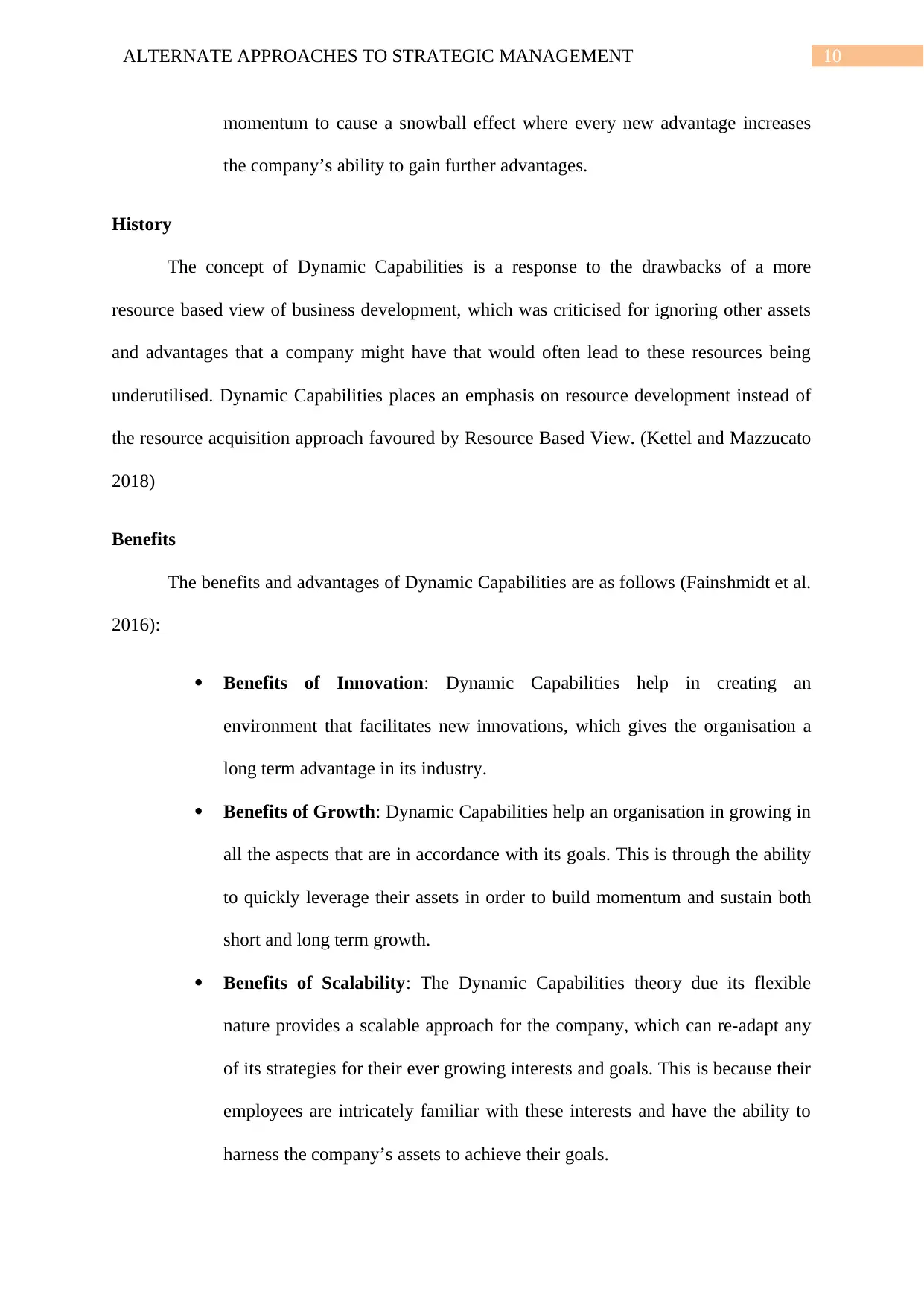
10ALTERNATE APPROACHES TO STRATEGIC MANAGEMENT
momentum to cause a snowball effect where every new advantage increases
the company’s ability to gain further advantages.
History
The concept of Dynamic Capabilities is a response to the drawbacks of a more
resource based view of business development, which was criticised for ignoring other assets
and advantages that a company might have that would often lead to these resources being
underutilised. Dynamic Capabilities places an emphasis on resource development instead of
the resource acquisition approach favoured by Resource Based View. (Kettel and Mazzucato
2018)
Benefits
The benefits and advantages of Dynamic Capabilities are as follows (Fainshmidt et al.
2016):
Benefits of Innovation: Dynamic Capabilities help in creating an
environment that facilitates new innovations, which gives the organisation a
long term advantage in its industry.
Benefits of Growth: Dynamic Capabilities help an organisation in growing in
all the aspects that are in accordance with its goals. This is through the ability
to quickly leverage their assets in order to build momentum and sustain both
short and long term growth.
Benefits of Scalability: The Dynamic Capabilities theory due its flexible
nature provides a scalable approach for the company, which can re-adapt any
of its strategies for their ever growing interests and goals. This is because their
employees are intricately familiar with these interests and have the ability to
harness the company’s assets to achieve their goals.
momentum to cause a snowball effect where every new advantage increases
the company’s ability to gain further advantages.
History
The concept of Dynamic Capabilities is a response to the drawbacks of a more
resource based view of business development, which was criticised for ignoring other assets
and advantages that a company might have that would often lead to these resources being
underutilised. Dynamic Capabilities places an emphasis on resource development instead of
the resource acquisition approach favoured by Resource Based View. (Kettel and Mazzucato
2018)
Benefits
The benefits and advantages of Dynamic Capabilities are as follows (Fainshmidt et al.
2016):
Benefits of Innovation: Dynamic Capabilities help in creating an
environment that facilitates new innovations, which gives the organisation a
long term advantage in its industry.
Benefits of Growth: Dynamic Capabilities help an organisation in growing in
all the aspects that are in accordance with its goals. This is through the ability
to quickly leverage their assets in order to build momentum and sustain both
short and long term growth.
Benefits of Scalability: The Dynamic Capabilities theory due its flexible
nature provides a scalable approach for the company, which can re-adapt any
of its strategies for their ever growing interests and goals. This is because their
employees are intricately familiar with these interests and have the ability to
harness the company’s assets to achieve their goals.
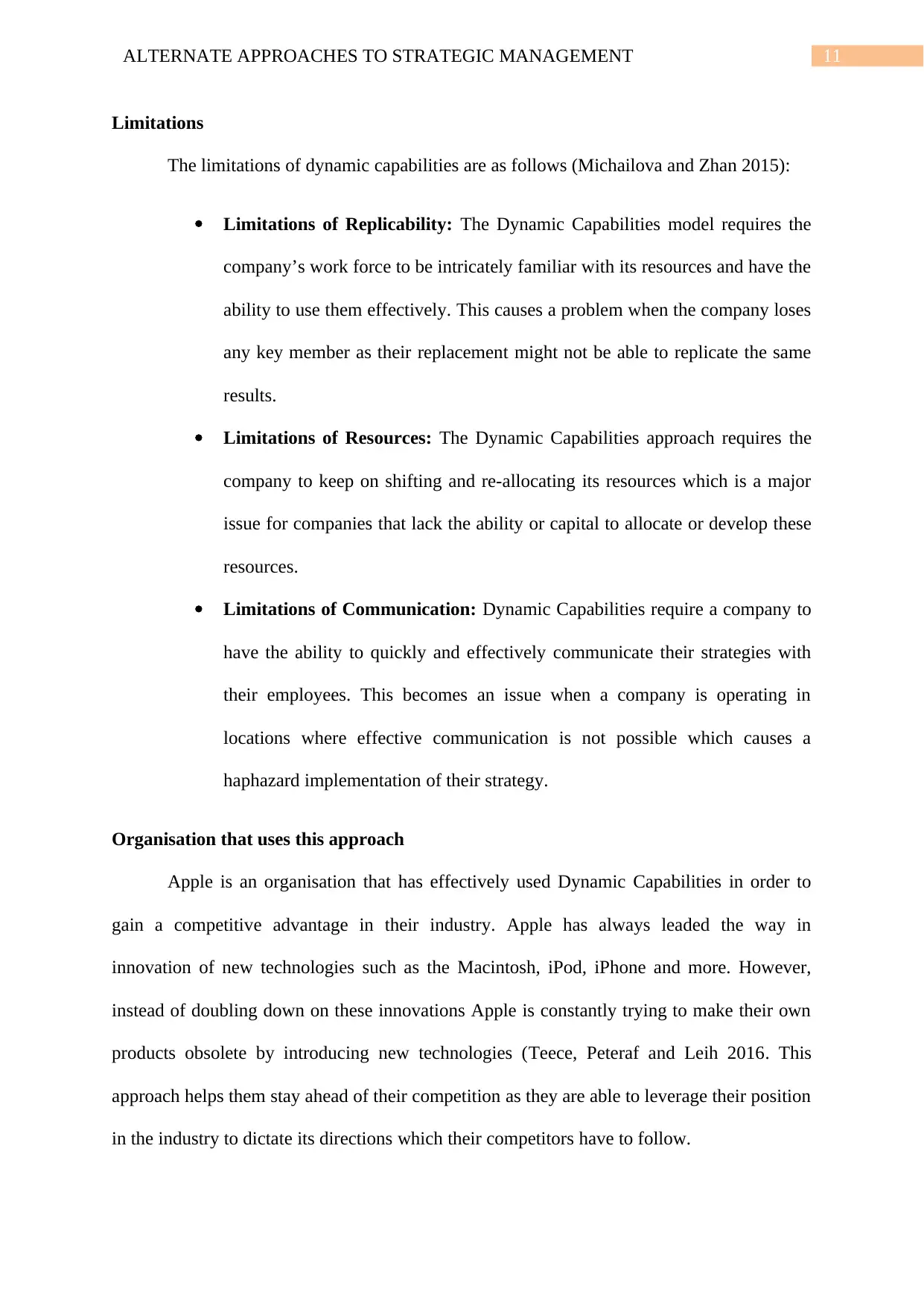
11ALTERNATE APPROACHES TO STRATEGIC MANAGEMENT
Limitations
The limitations of dynamic capabilities are as follows (Michailova and Zhan 2015):
Limitations of Replicability: The Dynamic Capabilities model requires the
company’s work force to be intricately familiar with its resources and have the
ability to use them effectively. This causes a problem when the company loses
any key member as their replacement might not be able to replicate the same
results.
Limitations of Resources: The Dynamic Capabilities approach requires the
company to keep on shifting and re-allocating its resources which is a major
issue for companies that lack the ability or capital to allocate or develop these
resources.
Limitations of Communication: Dynamic Capabilities require a company to
have the ability to quickly and effectively communicate their strategies with
their employees. This becomes an issue when a company is operating in
locations where effective communication is not possible which causes a
haphazard implementation of their strategy.
Organisation that uses this approach
Apple is an organisation that has effectively used Dynamic Capabilities in order to
gain a competitive advantage in their industry. Apple has always leaded the way in
innovation of new technologies such as the Macintosh, iPod, iPhone and more. However,
instead of doubling down on these innovations Apple is constantly trying to make their own
products obsolete by introducing new technologies (Teece, Peteraf and Leih 2016. This
approach helps them stay ahead of their competition as they are able to leverage their position
in the industry to dictate its directions which their competitors have to follow.
Limitations
The limitations of dynamic capabilities are as follows (Michailova and Zhan 2015):
Limitations of Replicability: The Dynamic Capabilities model requires the
company’s work force to be intricately familiar with its resources and have the
ability to use them effectively. This causes a problem when the company loses
any key member as their replacement might not be able to replicate the same
results.
Limitations of Resources: The Dynamic Capabilities approach requires the
company to keep on shifting and re-allocating its resources which is a major
issue for companies that lack the ability or capital to allocate or develop these
resources.
Limitations of Communication: Dynamic Capabilities require a company to
have the ability to quickly and effectively communicate their strategies with
their employees. This becomes an issue when a company is operating in
locations where effective communication is not possible which causes a
haphazard implementation of their strategy.
Organisation that uses this approach
Apple is an organisation that has effectively used Dynamic Capabilities in order to
gain a competitive advantage in their industry. Apple has always leaded the way in
innovation of new technologies such as the Macintosh, iPod, iPhone and more. However,
instead of doubling down on these innovations Apple is constantly trying to make their own
products obsolete by introducing new technologies (Teece, Peteraf and Leih 2016. This
approach helps them stay ahead of their competition as they are able to leverage their position
in the industry to dictate its directions which their competitors have to follow.
⊘ This is a preview!⊘
Do you want full access?
Subscribe today to unlock all pages.

Trusted by 1+ million students worldwide
1 out of 15
Related Documents
Your All-in-One AI-Powered Toolkit for Academic Success.
+13062052269
info@desklib.com
Available 24*7 on WhatsApp / Email
![[object Object]](/_next/static/media/star-bottom.7253800d.svg)
Unlock your academic potential
Copyright © 2020–2025 A2Z Services. All Rights Reserved. Developed and managed by ZUCOL.





